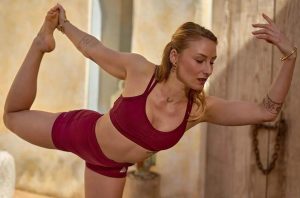Yoga for Mental Health: Exercise for Mind and Body
Yoga has been shown to have more beneficial effects on mental health than other types of exercise. ( 11 ) You won’t burn as many calories as you would running, and you won’t build muscle as you would with barbell strength training. But you will exercise your mind-body connection in a yoga class, which may be the best of all workouts.

Positive Psychology Yoga
Stretching has been shown to lower cortisol levels in the body and has positive psychosocial outcomes, whether you do it independently or in a group class. ( 12 ) Women, in particular, are less likely to objectify themselves and suffer from eating disorders when practicing yoga. ( 13 )
Yoga: The Phenomenon of Positive Thinking
Although positive thinking is a term that often appears in popular culture, it has actual psychological benefits. Positive thinking is a quality of non-judgmental, observational attention to one’s current experience. Positive thinking means feeling curious, experiential, open and receptive to one’s current state. Positively mindful people have proprioceptive and interceptive abilities; they use their senses to interpret their bodies and their world. Very mindful people become more aware of their interpretations, beliefs, memories, conditioning, attitudes and influences on the earth.
Yoga is considered a mind-body therapy that teaches the practitioner to be mindful. Yogis are usually more confident in their public and private interactions. Scientists who study yoga even call it the “positive thinking phenomenon”. ( 14 )
How can yoga help you stay healthy?
If you are just starting or restarting your workout, yoga will help you build muscle and cardiovascular health. If you are already exercising, yoga can complement your current workout, making it more effective and less likely to cause injury. Finally, yoga can help everyone maintain their mental health.
Power Yoga or Aerobic Training
Those who exercise regularly may also notice a change in physical condition when practicing yoga, especially if they set clear goals for their practice. Those who regularly strength train should do cardio yoga, while runners can do yoga to increase their strength. More detailed information on which type of yoga should be done and why is provided below:
Hot yoga is a challenging type of yoga performed in a hot, stuffy room. It has been shown to help people increase the amount of weight they can pull hard. ( 1 ) And, because heat causes the heart rate to rise, it may contribute to cardiovascular health.
Holding yoga in challenging poses for long periods of time will increase strength. Holding poses until you feel muscle fatigue is key to building more muscle. styles such as Ashtanga and Power yoga naturally incorporate these isometric contractions.
Fast flowing styles of yoga, such as flow yoga, can build cardiovascular endurance and strength. Begin by learning a series of poses and then linking them together (usually one breath, one movement). Beware: certain yoga poses are dangerous when improperly connected in the flow. It is best to learn yoga flow from a trained practitioner.
Older adults are especially likely to derive cardiovascular benefits from yoga ( 2 ). So get Grandma together! Even if you don’t see a significant increase in running, yoga has been shown to improve overall cardiovascular health. ( 3 ) Your lungs will feel healthier!
Flexibility Yoga
While flexibility won’t help you lose weight or build muscle, it is an indicator of fitness and physical health. One study showed that a regular yoga practice specifically increased flexibility for computer users. Even simple, short chair yoga sessions can make you more flexible, especially if you do it regularly.
If your only goal is to increase flexibility and range of motion, then you need to do yoga at least twice a week. If you want to become more flexible in certain areas of your body (for example, hamstrings or lower back), you will need to do at least 5 minutes of static relaxation stretches for specific areas of your body each week. You can hold the stretch for 2.5 minutes in two different sessions, or for 5 minutes in one session. ( 4 ) Yin yoga is a type of yoga that involves holding and relaxing static stretches for a long period of time.


































